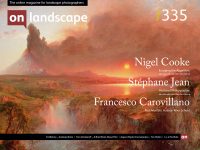Andreas Brink chooses one of his favourite images

Andreas Brink
I'm a self-taught photographer and started taking pictures at young age with an analogue film camera which later has been replaced by a full frame digital camera. I like great landscapes, but also to capture details, shapes and forms in the landscape. Beside photography I work with images on a daily basis, even if of a special kind. I'm a Geographer working with satellite images. Living in Italy I consider myself a true citizen of the world (or at least Europe), since I'm of German origins, born in Italy and married to a Swede.
Sometimes in life, you set out with a certain idea, a narrative you want to follow, but then an unexpected event shifts your course entirely. That happened to me here. My original plan was to present as an “End Frame” a photograph by one of my favourite Italian photographers, since I am half-Italian myself. But then on the seventh of August, Gianni Berengo Gardin, one of the most prominent Italian photographers of the twentieth century and also one of my favourites, passed away. That news made my choice clear, this piece would become not just an introduction and discussion of a photograph, but also a small tribute to one of Italy’s most poetic and human storytellers who chronicled the life of a country for more than half a century.
Born in 1930 in Santa Margherita Ligure, Berengo Gardin always considered Venice his true birthplace. It was in Venice that he first picked up a camera in the early 1950s, photographing as an amateur before eventually turning professional. He never abandoned the city in spirit, even when travelling and being on assignment elsewhere. Indeed, it was there, late in life, that he fought tirelessly against the arrival of large cruise ships, seeking to protect Venice’s fragile beauty from mass tourism. His Venice photographs, both early and late, reflect a rare intimacy with the city, showing the everyday life of workers, children, and artisans, documenting the often hidden realism of this unique city.
From this Venetian period, I have chosen Lido di Venezia (1959), an image that resonates with my own photographic thinking. The composition is simple and minimalistic, two adults and a small child in a pram stand at the shoreline.

